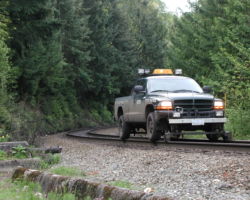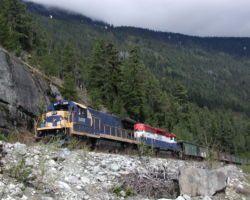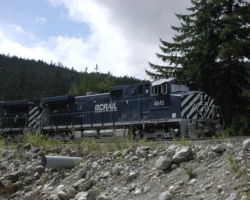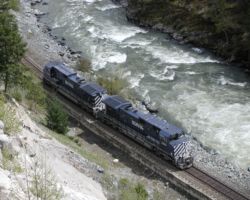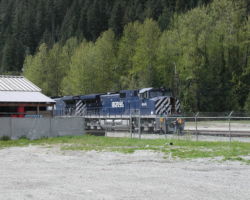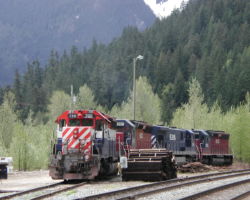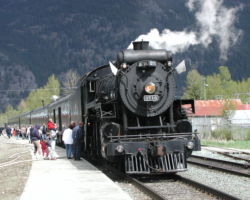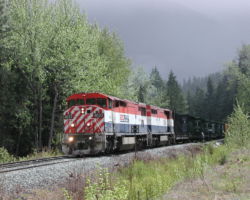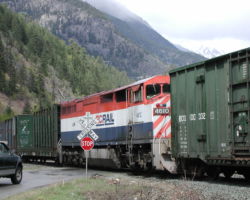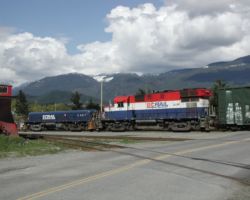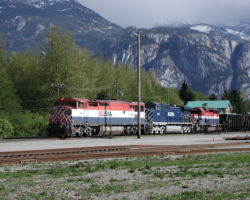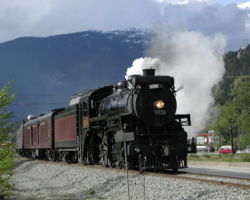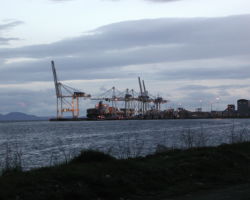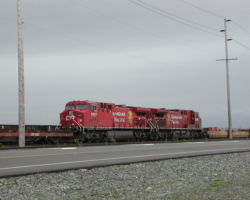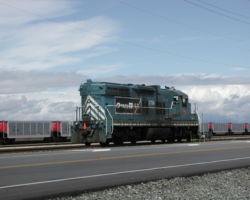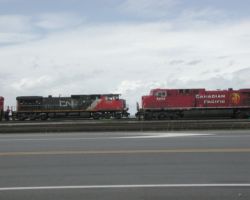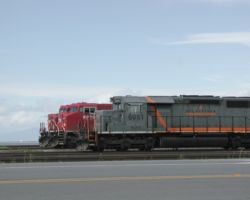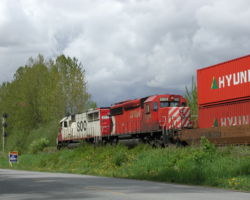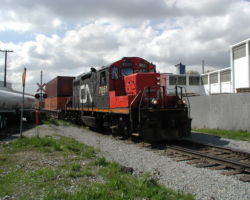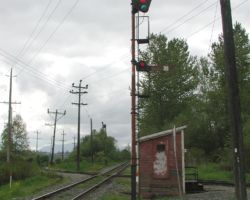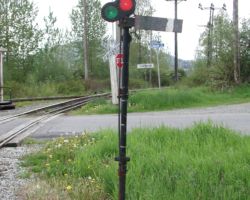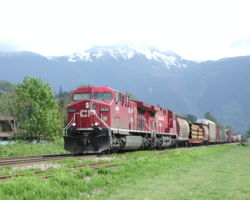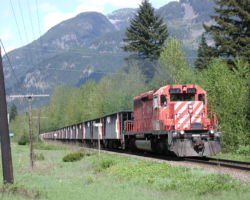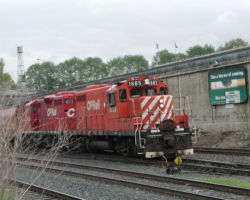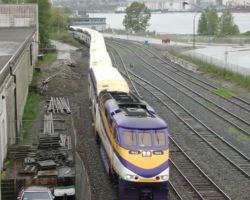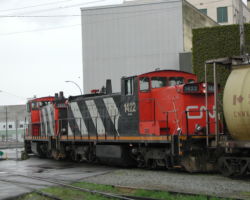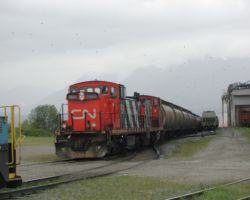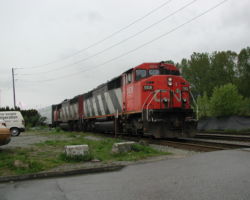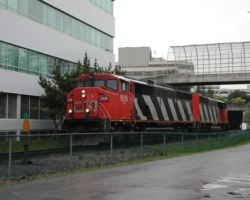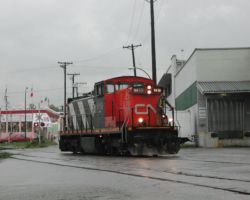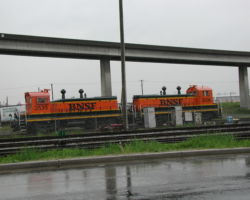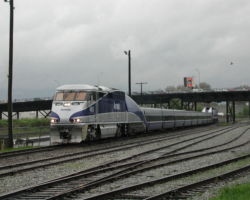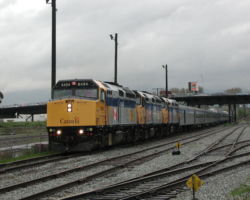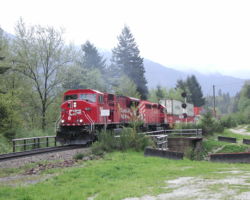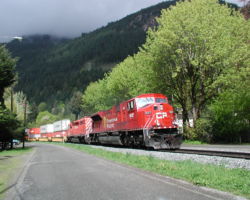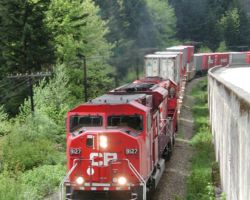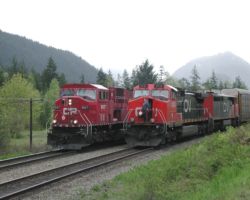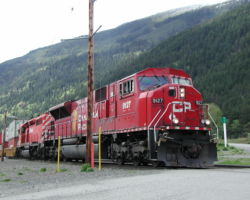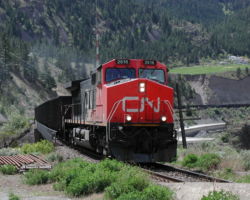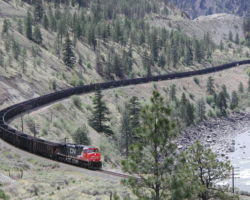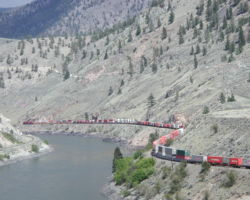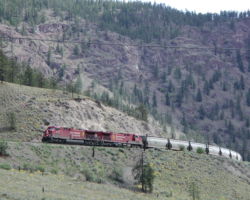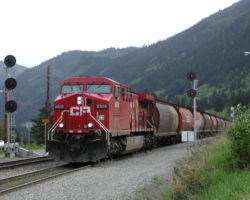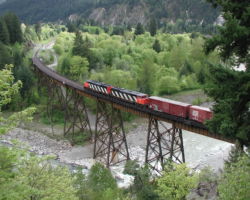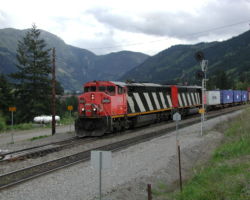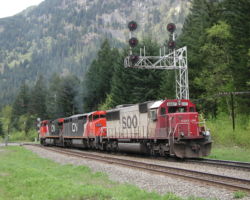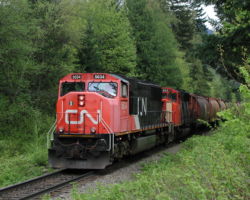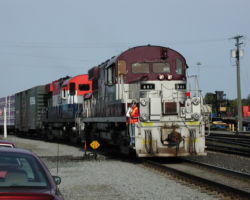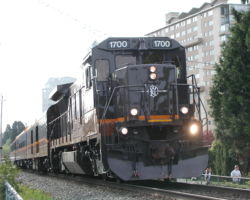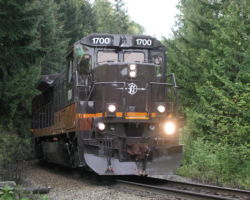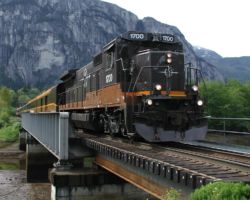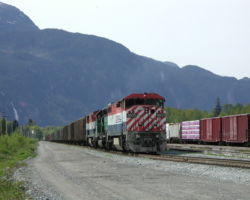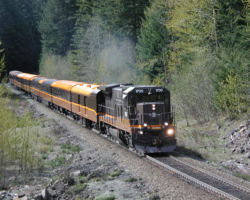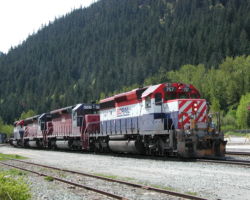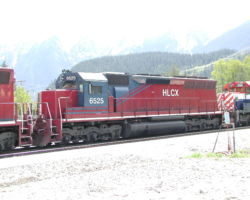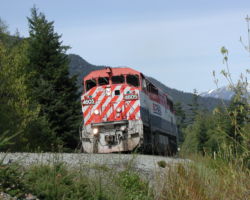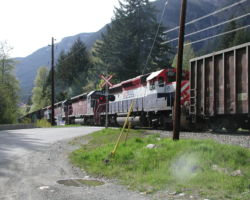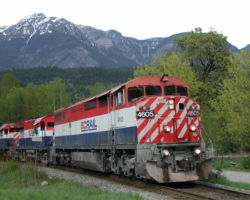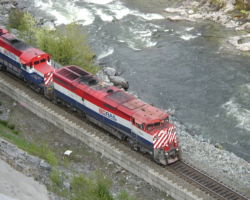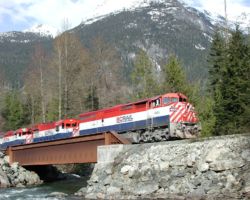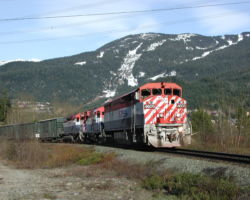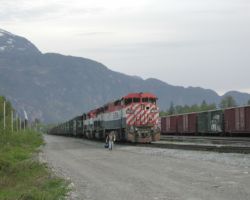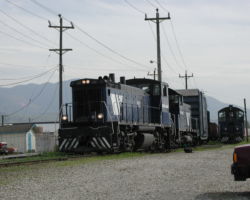Sea to Sky with BC Rail – Sat, Apr 28, 2001
About twice a year, I get sent out on the road to field test new software. Last summer took me to San Diego, CA, but this year the powers that be sent me out to the international test site in Vancouver, BC, Canada. The trip was delayed and cancelled several times due to various issues, but finally, on April 27, 2001, I was headed up to Canada. As it turns out, this delay would be a bit of a blessing, as most of the bugs were worked out in the domestic testing (which happened right on schedule in early April). Just as a generic note for those of you thinking of travelling that way – make sure you check that your passport is still valid before you go, or have one of the other various forms of proof of US citizenship handy. I discovered that morning that my passport expired two months ago, and my birth certificate is still back in my parents’ house in Iowa. So, with my driver’s license and voter registration card in hand, there I went… (I called Canadian Customs early to make sure this would be adequate, but just get a passport, it’s easier and necessary if you go pretty much anywhere else.)
I actually arrived in Vancouver late on the night of the 27th. I’d intended to get there in good time (around 1900h) so I’d have a bit of light in which to figure out the layout of the city and find a hotel with quick access to the Hwy. 99 and BC Rail. As usual, this was not to be. We sat in Denver to nearly two hours because the left engine on our 737 just wouldn’t start. Working for an airline, I understand how these things happen, but it’s still very annoying. Anyway, I finally arrived in a dark, rainy Vancouver around 2100h, and after an hour of waiting, talking to customs, waiting, getting my bag, getting lost, and getting my wonderful rental car, I think I finally got out of the terminal around 2230h. Now, it’s dark, the internal sense of direction in my head is all fouled up for some reason, and I don’t have a hotel yet. Arg… After half an hour or so, I settle on a hotel in Richmond, somewhat near the airport, though as lost as I was, I never knew it.
Saturday actually dawned beautiful and sunny, and at long last I could somewhat orient myself with the city. Of course studying maps of the place for about twenty minutes the night before certainly helped, but now with sunlight I could actually start putting most of it together. Either way, I was entirely on the wrong end of the town to get at BC Rail.
For those unfamiliar with Vancouver, the city is split by several large and/or deep inlets of water. The major one, the Burrard Inlet, is at the upper end of town, between the semi-flat area that makes up Vancouver, Richmond, Burnaby, etc, and North/West Vancouver and the rugged mountains of the BC coast. To the south is the Fraser River delta, and its several arms. I’ve included maps (Photo #1), extracted and modified from Microsoft MapPoint, that shows some of the major highlights of railroad action around the Vancouver metro area. (Side note: As many of you know, I’m really a Delorme Street Atlas fan, but being as they don’t include Canadian maps, the MS product worked out nicely. Unfortunately, it’s level of railway detail is not all that great.) The section I was interested in today was the BC Rail North Vancouver yards, and the mainline going north along Highway 99, but we’ll get to all of the other marked locations a bit later in the trip.
Because I slept in, I missed the morning Budd RDCs going north out of the North Vancouver station. BCR still runs daily passenger service out of NV, supplied by the little silver and blue Budds. However, they depart the NV station around 0700h, long before my eyelids are usually open on non-work days. While access to the station and the nearby tracks is relatively easy, security seems very tight around BC Rail facilities. Within minutes of parking and getting out with a camera on the south side of the station (it’s a public road), there was a BC Rail security truck coming over to check on me. Also, the word from local railfans is that they’ve been handing out quite a few trespassing citations lately, so watch it and respect their property. Unfortunately, even with the camera out, good light, and security keeping an eye on me, there really wasn’t anything happening, so I decided to proceed north to Squamish.
Highway 99, which follows the coastline up to Squamish, is known as the Sea to Sky highway, and for good reason. It starts off at nearly sea level, and quickly works its way high up on the cliffs overlooking the ocean. BC Rail’s mainline follows along the bottom of the cliffs, 10-20 feet off the water, I’d guess. Once you leave West Vancouver, and possibly Horseshoe Bay, there aren’t any really promising photo locations for some distance. The railway is just simply too far down, the cliffs are too steep, and pulloffs too infrequent to make this a good area for railfanning. That doesn’t even get to the fact that you’re on the east side of the tracks, and the cliffs block all morning light. The first really decent shot is at Lions Bay, about 25km from the NV yards. Beyond this, there’s good access and light at several points, such as Britannia Bay, between there and Squamish. You’ll also get advanced warning of trains on this section – pilot trucks (green BCR Dodge Dakotas with amber flashers on the top, Photo #2 from later in the week) operate a few minutes ahead of trains, due to the threat of landslides, grade subsidence, etc. Oh yes, and as a note, there are quite a few insane drivers on this road, and as I understand the number of accidents is quite high – be careful out there, as a few too many seconds gawking over the cliffside will get you in serious trouble when the road turns and you don’t… Almost every other railfan I met up there gave me at least a short warning about this stretch of road, and I did meet a few of the aforementioned nutcase drivers – mainly with US plates…
Unforunately, Squamish was also silent – aside from another truck (presumably security) that came over to check on me when I parked just off the road at the north end of the yard. They’re very clear with the No Trespassing signs, and they’ve got them at every possible yard entrance. However, there is a gravel pulloff at the north end, just across from the West Coast Railway Association’s museum. Looks like quite a place, though I didn’t get time to visit. Back to the point, this pullout provides a handy place to put the car while photographing trains moving in and out of the north end, all while being on public property. It’s quite handy, and many of the photos you’ll see in this trip report from Squamish were taken from this area. All this security stuff was getting a bit unnerving for someone who remembers the BCR of ten years ago (and my first cab ride, up on the very north end of the system), so I grabbed lunch and headed north again.
The road between Squamish and Whistler only affords a few railfanning opportunties, as most of the time the road and railway are separated by canyons or mountains or trees or some such. There are a few good opportunities, but I never did see a train and by this time it had started to rain, so I just headed on. Whistler, as a town, reminds me a lot of what’s happened to Aspen or Vail in the last twenty years. Ick. Aside from a police photo-radar van (you have to watch out for those things, they’re very good at hiding them up there), nothing of interest here…
At this point, it was raining, getting colder, and the clouds were making for a very dark afternoon – not to mention I was almost to Pemberton already and hadn’t seen anything. I was starting to think I was going to get completely skunked for the day when, lo and behold, a really ugly ex-Santa Fe Dash-7 became visible ahead, coupled to a BCR SD40-2 and a ballast train (Photo #3). Just as I realized what I was looking at, the clouds began to open up a bit, letting through just enough light to make it worthwhile. It was, however, still raining – how this works with clear sky and rain falling I don’t quite understand (well, yes, I do, but it still seems odd). I’d barely gotten shots of the two units when I heard a rumbling. At first, my brain tried telling me it was thunder, then a logging truck, and finally I realized that it was the distinct sound of a GE prime mover doing work – and not the one I was looking at! Within seconds, two of the newer non-widebody GEs came into view, travelling northbound and light (Photo #4). Unfortunately they were very backlit at this point, but at least now I had something moving to work with.
Just south of Pemberton is an overlook to Nairn Falls. For some reason, I remembered that it was there from an earlier trip, and hurried to catch the two units as they approached it. (Photo #5) This was to be my first lesson in BC photography – while the sun may be shining, the bottoms of canyons are still dark, and water will screw up the exposure every time. My shot of them passing the falls didn’t work so well as a result, but #5 came out just fine. The crew actually stopped the units for a minute at the falls while one got out and walked over for a look. Then, just as unexpectedly as they’d stopped, the crewmember got back onboard and they departed again for Pemberton.
Pemberton, BC, has long been the home of helper sets. They’re often sent up beyond D’Arcy to be spliced into trains and help them over the grades and down into Whistler, at which point they’re cut off and sent back up to Pemberton to get ready for the next train (Photo #6). The fact I was seeing a northbound set returning means I’d missed a train some time earlier, but at the time I didn’t realize this. As of Saturday, April 28, 2001, there were these two modern GEs, SD40-2 #758, HLCX SD45-ish units #6507 and 6525, and BCR Dash-7 #3624 (Photo #7). Also sitting in Pemberton was something completely unexpected – BCR #3716 (a 4-6-0 steamer) and a passenger train, complete with real passengers and sitting right on the mainline. (Photo #8) Within minutes of taking the photo, though, the rain caught up with us again, and I scrambled back for my car. This train was some sort of special charter run working south towards Vancouver, I later learned. It’s certainly not normal to see steam this far up the line.
After stopping for gas and chocolate, I continued north towards D’Arcy, the northernmost point on BCR you can get to from Vancouver without diverging from the railway for some distance (Hwy. 99 spends almost 100km between Pemberton and Lilooet away from the BCR main, whereas a diverging backroad near Pemberton will follow the line to D’Arcy, about halfway in between.) Once again, the first 45km showed no sign of anything except rain and gloom. Maybe I was just being self-depressing… Still, the typical schedule of trains someone had sent me before I left showed a northbound freight that left Vancouver around 0800h, and I still had some hopes I might catch it.
Just a few kilometers short of D’Arcy, I did. Once again, the clouds broke open (it’s moments like this that make me swear that ,the Almighty is a railfan) and shortly thereafter I spotted a few Sultran sulphur cars disappearing around a corner. Thanks to a ballast tamper working on the south switch at D’Arcy, it bought me a few precious minutes I needed to get ready for its appoach. Almost as if on cue when the light came into its prime, 4622 and 4621 came out of the trees and headed on north. (Photo #9) A few minutes later, 4610 showed up as the mid-train on this particular northbound (Photo #10). The road crossing the tracks here is the road north, but it dead ends just another km or so up the line. There supposedly is a 4×4 road north along the line to Lilooet, but needless to say my Chevy Cavalier wasn’t going to make it, especially in the pouring rain and mud.
At this point, it was almost 1430h, so I decided to head back home. Even if I’d wanted to go on, there was the 50-ish km drive back down from D’Arcy to the main highway near Pemberton. I decided I didn’t really want to go any further north, so back home it was. At least the weather was clearing, and at least the first hour to Pemberton was under blue skies and sunlight. Unfortunately, radio stations are a bit rare up here, and due to the mountains even the ones that do exist don’t carry very far. Note to self: next time, remember your CD collection. Still, the sunlight and fresh air made for a pleasant trip.
Not much was seen until arriving back at Squamish around 1330h. When I did arrive, the yard was much livelier than I’d left it before – Cat-repowered RS18 #611 was out with its slug (S407) switching cars (Photo #11), and a northbound from Vancouver was trying to cut a few cars out as well (Photo #12). No sooner than they had both cleared the main than the sound of steam power was heard off to the north – apparently I’d beaten the special back to Squamish, and with good light and no rain, it would make an interesting bit of traffic going back to Vancouver.
After sitting for almost an hour and taking on water, 3716 finally got underway southbound, and of course there were a few more railfans following it. The best photo location I found, in view of how low in the western sky the sun was getting, happened to be at Britannia Bay, about 10km south of Squamish. Even with slow traffic, I still beat 3716 in handily, and had my pick of shots. I settled on one from a grade crossing near the center of town, where I could get on the western (lit) side of the line. (Photo #13)
After that, and a few more attempts at shots futher south that didn’t work out (and one that did, about halfway back to Lions Bay – Photo #14), I decided to call it a day. It was starting to rain yet again, and the light was gone. So I drove back to my hotel down in Richmond, BC, and started looking over the day’s efforts. After a while, though, the urge to go get some dinner overcame me, and on the way I decided to run down to the Roberts Bank Superport, where tons of CP/CN intermodal and coal traffic are transloaded to and from ocean-going vessels. Being late on a Saturday, not much was happening, but at least I knew where the place was now. As it turns out, there’s quite a gravel parking area between the main access road and the ocean inlet, which is surprisingly good for watching trains/ships/waterfoul in the afternoon – or hundreds of semi trucks, if you like that order of thing. Either way, after that I really did call it a day.
Rain and Railfanning Around Vancouver – Apr29 – May 4, 2001
The main reason I live in Colorado is I like dry, sunny weather. Vancouver is the antithesis of that – it’s rain and humidity continuously, and it was more than happy to show that for most of the beginning of the week. From Sunday to Wednesday, most of the days were rainy and cold, but with only 10 days there, it certainly didn’t slow me down all that much. Within the Vancouver metro area, there’s still tons of railfanning to be done.
Sunday was incredibly dreary and rainy, and consequently mainly spent sleeping and exploring the immediate area, including trips to Roberts Bank, the North Vancouver BC Rail yards, CN’s Thornton yards, and a general drive around the place. The only thing of real interest found and photographed was an eastbound set of empty intermodal cars headed out of Roberts Bank behind a pair of CP GEs (Photo #15). However, also on the interesting list were a set of E-units parked over at Thornton. However, due to pouring Also,rain and bad light, I passed on photographing them. The whole day couldn’t be spent railfanning, though, as I had work issues to attend to that afternoon at 1400h.
Monday, being the first day of software testing for me, only provided a few mid-day hours to railfan between morning and evening package sorts. Really the only place I could reach in time was back to the Roberts Bank facility, along with exploring down along a CN branch south out of Richmond. Fortunately, being a genuine work day, there seemed to be quite a bit more action around the port, and by the time I drove down there the clouds had begun to part. One could tell this a few miles away, as the level of container truck traffic on the highway had gone from unnoticed on Sunday to nearly traffic jam proportions today.
One of the first things I observed was all the BC Rail signs around the property. It seems, while CN and CP actually move the freight in and out of the facility, BC Rail is apparently the actual owner of the railyard and possibly the line leading into it. As best I can tell, BC Rail doesn’t serve the property, just own it. In fact, it appears that even switching services are provided by Omnitrax (yes, Omnitrax of Loveland, CO), as evidenced by the fact that OMLX 1750 was running around doing all the yard work (Photo #16). I probably sat down along the spit leading to the port facilities for an hour or so, and managed to catch a small amount of movement, mainly composed of in and outbound CP and CN coal trains. One of the most interesting was an inbound and an outbound passing each other. (Photo #17)
As I was about to leave, an inbound stack train showed up, powered by some very odd SD40-2s, apparently owned by GEC Alsthom and leased back to the Canadian National. I’d almost say these look like old CN SD40-2s, but I have absolutely no proof of this – anyone care to enlighten me? I’d seen quite a few of these when I’d passed by CN Thornton on Sunday, but it was nice to actually get a photograph of one, and with two shiny CP GEs behind it even (Photo #18). The orange stripe certainly makes them distinctive…
Tuesday started looking much better. Work had gone well, so I took off around 0830h and decided to venture out along the north shore of the Fraser River, up towards Mission, BC. Hwy 7 follows the tracks quite nicely through here, but unfortunately MoW work had shut down the mainline pretty solidly. The only thing seen barely moving was Soo 6019 and CP 5869 creeping up to a red signal with a westbound stacker, somewhere around Maple Ridge, BC (Photo #19). I did manage to find the interlocking between the CP and the Southern Railway of British Columbia just north of Abbotsford, BC, complete with semaphores, but again, the light was bad and the rain was pouring, so I decided to just head back to work for the afternoon shift.
Wednesday was a new story, though – better weather, and I was getting to know the area well enough to start to barely understand train movements, or at least have some idea of where to go looking for them. So, I decided this would be a good day to press further up the Fraser, from Mission to Hope. So, after work, I headed back to my hotel in Vancouver to put on some clothes appropriate to railfanning (jeans) and headed west. Only a mile or so from my hotel, the gates came down in front of me, and I was lucky enough to catch a CN transfer job moving intermodal cars across town (Photo #20). After it had passed, I jumped on Trans-Canada Hwy. 1 in Burnaby, went west to Abbotsford, crossed over the Fraser and proceeded west along the CP/eastbound mainline (on the north side of the river). While I’m not sure how far down it goes (as there is a rail bridge at Mission), above this point and through the rugged parts of the canyon beyond Hope directional running is in effect. CN and CP westbounds travel on one side of the river, and eastbounds on the other. Unfortunately, being a nice day, the track gangs were out doing significant work on the line and holding up traffic. Fortunately, a few trains would slip through.
Before crossing over the river, though, I decided to stop and have a look at the semaphores again. So, for all of you blade fans, I’ve posted a few photos. As best I can tell, it seems they still work, though I never saw a train on the line to verify this. The control point in question is just north of Abbotsford, where the Southern Rwy of BC turns and heads west across the CP branch coming down from Mission (and across the Fraser). Photos #21 and #22 show these nicely – the large dual-bladed signal guards the CP line, while the short stubby ones control SRY trains. In addition, there are single-blade approach signals on the CP line.
The first train was a westbound junk train about halfway between Mission and Hope, powered by the usual General Electrics. I actually caught up with this one several kilometers down the road, but had to backtrack significantly considering the speed with which it was moving. Thanks to a slow order by a work crew, though, it was an easy catch in the end. (Photo #23) The rest of the trip was relatively uneventful, aside from catching a beat-up CP SD40-2 just north of Hope with a rock train. (Photo #24) I remember when these things used to be the norm, and they all looked good. There’s nothing quite like seeing 6-7 SD40s coming down the line at you, but this guy was definitely a homely, pathetic example of the previously huge fleet.
Thursday, unfortunately, wasn’t much fun – mainly rain, clouds, and cold, so I spent a good amount of time sleeping to make up for all those 0430h mornings. Later in the afternoon, though, I did get the ambition to actually go find a few trains. My main goal was to find one of the West Coast Express trains in action. These are F59PHI-powered commuter trains that run from Mission into Vancouver in the morning, and reverse at night. As a note: These don’t come in to Pacific Central Station – rather, they use a terminal down by the Vancouver waterfront on the Burrard Inlet. It just so happens that there’s a road running down along the waterfront from downtown clear out to Burnaby and the Second Narrows bridge (where TC-1 crosses in the Inlet). While it’s marked with large “Caution: Heavy Industry Area – Private Road” signage, locals seem to use it just like any other street. At that point, I decided a cautious railfan could probably manage to get through there without problems – but I will note, it is a very heavy industry area, with trains and trucks going every which direction in and out of the port facilities all along the road. Be very careful, and don’t get in the way.
The first productive catch was a CP switch job near the west end of the road (Commissioner Street, if my map is accurate, starting by New Brighton Park, almost under the Second Narrows Bridge). They were switching long strings of grain cars for presumably offloading and transloading into oceanliners. (Photo #25) However, I noticed my watch indicated that a WCE train would soon be appearing, so I took up a position on the road bridge above the park and waited. About 8 minutes after his scheduled departure from the station, the F59 appeared around the corner, and before I could get more than one shot off, was gone under the bridge. (Photo #26).
At this point, I ventured further down the road, more towards the active industrial area. There are several large grain and container facilities off on the north side of the road, and the main line is always on the south. Consequently, there’s quite a few railways crossing the highway. Coming up on just such a crossing, I found my path blocked by a string of Canadian grain cars (those interestly-painted cylindrical types). Parking the car in a nearby parking lot, I jumped out with the camera just in time to get shots of a pair of GMD1s crossing the road (Photo #27) and backing the cars down to later be unloaded (Photo #28). Quite a sight – I didn’t realize any of these unique roadswitchers were still in service, but based on these and another I found down the road, I’d have to say they’re doing nicely.
The last stop for Thursday was North Vancouver, since I’d seen a long CN haul crossing the Inlet as I was waiting for the WCE train to arrive. As it turns out, CN has a medium-sized yard on the north side of the Inlet as well, and apparently serves quite a few port facilities as well as BCR from there. The train I’d seen had disappeared into an inaccessible piece of the yard, but I noticed some light power heading west. As it turns out, they’d been sent over to the BCR yards to pick up a cut of cars and drag them back – presumably interchange traffic. (Photo #29) Of course, being Vancouver, by this time it was raining again…
Friday wasn’t very productive either. Despite having the entire day off after 0900h, the weather once again put dampers on any sort of railfanning ambitions I had. However, as it did start to at least dry off in the afternoon, I started out to get a few photos of something, anything, just so I hadn’t wasted the entire afternoon. I’d also decided that the main goal for the day was going to be passenger trains rolling out of Pacific Central – namely VIA’s eastbound Canadian and Amtrak’s southbound Cascades.
Since I had some time to kill before both were due to depart, (VIA is scheduled for 1730h and Amtrak for 1800h – I think when I left it was only around 1500h) I decided to take the long way over, via North Vancouver. Yes, I know, I’m really showing my desparation to see a BC Rail freight here, but still… Once again, the only thing I caught was the CN transfer job coming west to pick up a cut of cars. (Photo #30) On the way back, though, I caught another GMD1 poking around, with a crewmember on the front that looks a lot like a crusty old sea captain. (Photo #31) Oh well, at least he had the brains to dress for the weather; he has to be wondering what the dumb railfan is doing out without even a coat…
After waiting some time, the Canadian and the Cascades left within minutes of each other – Amtrak nearly on time, VIA nearly an hour late (if I can read my timetables correctly). While waiting, I did take a photo of a pair of BNSF switchers sitting beside PCT’s exit, idling away (Photo #32). (For reference, the overhead bridge-like thing in the background is the track for SkyTrain – Vancouver’s light rail system. I didn’t get a chance to ride it, but by the looks of it it’s well utilized and is currently undergoing quite an expansion.) Finally, though, the two passenger trains did pull out, and from my vantage point on Vernon Drive and East Fourth Street, I handily got shots of both of them (Photos #33, #34). After that, it was off to find some dinner and go back to the hotel.
The Fraser and Thompson River Canyons – Saturday, May 5, 2001
“Enough piddling around Vancouver, with all its traffic and switch jobs and, ugh, rain,” I thought. For the weekend, I’m going to get some quality distance between myself and the city, and hopefully find some serious mainline railfanning. The first place that came to mind was the Fraser River canyon above Hope, BC. It’s rugged, the scenery is terrific, the lines are reasonably accessible, and I hadn’t been there in about six years. After all, all that traffic I’ve seen comes from somewhere, and no matter where somewhere is, it’s accessed via the Fraser River route.
The easiest and fastest way to get to the canyon is to just take Trans-Can 1 west from Vancouver. It, too, uses the FRC to head east towards Kamloops. I actually headed out around 0830h, and was in Hope by 1000h. After fueling my wonderful rental car, I headed up the line. (I should note that by this time, the right front wheel bearing was squeaking to the point I couldn’t stand having the windows down while driving.) The first thing I saw was the back end of a coal train stopped just north of Hope. Never did see the power, and assumed that it was probably tied down. However, a bit further up the line, almost to Yale, I met the back end of a stacker that was in the hole and just starting to roll again. At that point, I put coal and stack together and figured out there must have been a southbound I’d missed somewhere. Oh well, the light hadn’t been that great yet anyhow.
With the stacker still easing itself onto the main (lead by SD90MAC #9127), I had plenty of time to get ahead of it. However, just like the first day on BC Rail, it illustrates a fundamental difficulty of photography in BC – the sky is bright and reflective, the train almost always isn’t. Still, I didn’t think it a half bad shot (Photo #35). After that, I proceeded into Yale (and past another photo radar van, just like the one seen last Saturday) and caught him again coming through town – with just the opposite lighting problem! (Photo #36) I think it was also at this point I realized the same mangey-looking SD40-2 from the other day was back as the trailing unit – it’s amazing how the SD90 just makes it look better…
Another good shot presented itself north of Yale a few kilometers where the road and railway share a narrow section below the cliffs. Using a pullout a hundred feet up the road or so, and staying safely on the ground outside the guardrail, I managed the great head-on shot in Photo #37. Unfortunately it doesn’t communicate just how narrow and winding this road and railway really are…
Another few kilometers up the road and I noticed a mixed sitting in the hole. That made sense – the intermodal would almost certainly have priority. So I drove down beside the switch and waited patiently for 9127 to show again. In the meanwhile, a crew van showed up to pick up the crew, and gave me a few interesting looks (what, they’ve never seen a railfan before?), but they didn’t seem to mind as long as I stayed out of the way. Soon, the CP showed up and passed the sitting CN (Photo #38), and the crew promptly climbed down and into the van as soon as it had passed.
Beyond this point, the road crosses over the Fraser and proceeds to climb high up on the other (east) side of the canyon, which makes photography rather difficult as both mainlines tend to stay much closer to river level through this section. My advice would be to either turn back here or press on to Boston Bar as quickly as possible – it’s really the next useful photo opportunity, as typically the railways are several hundred feet below the highway and obscured by trees until Boston Bar.
Just south of Boston Bar I found what had to be the photo opportunity of the trip – a high curved steel trestle crossing what I remember to be Anderson Creek. Unfortunately, a decent photo op would require a train, and I’d seen track crews working on the westbound (CN) mainline at several points back down the canyon. As I came down into Boston Bar, I did notice three trains sitting in the yard there, but all apparently idling and waiting for the work window to lift. I didn’t feel like waiting just then, so I proceeded to grab a sandwich and take a restroom break at the local gas station.
Feeling much better, I drove across the Fraser (on a bridge, obviously…) to check out the CP facilities on the west side, and to my surprise the stacker from earlier showed up for a crew change (Photo #39) After that, on up the road I went. Between Boston Bar and Lytton lies Cisco, where the lines switch sides in the canyon on spectacular bridges. Unfortunately, the M-o-W crews were here, too, meaning no trains anytime soon. After Lytton, the road and railways actually turn east to follow the Thompson River, and the scenery changes from coastal rainforestish to semi-desert almost immediately. The change is almost startling it’s so rapid. Just coming out of Lytton I spotted the back end of a coal train moving along…
One thing I really noticed up here is the lack of power on everything. Following this empty coal train, I couldn’t see anything in terms of mid-trains and I could only discern one unit on the front end. My mind just didn’t believe it, though, that CN would run a huge string of empties up through the mountains with a single unit, but then again I’d seen many CN and CP loaded trains coming in with only one unit on the front and one in the middle. Finally, about halfway up to Spences Bridge, I got far enough ahead to pull off and get a few shots (Photos #40, #41). Yes, that’s right, just a single GE on the front – no mid-trains, no nothing. I’d thought the grade was more severe than that, but I guess this proves that it’s not.
After that, I finished the drive up to Cache Creek, which turned out to be largely a waste of time. Once I’d passed this one, I saw no other action for the remaining hour drive. Coming back, however, I encountered the same old stack train again about 20km south of Cache Creek. Watching it twist and wind down the canyon really gives one an appreciation for how small these things are compared with the natural wonders around them (Photo #42). A few more miles back I met up with another northbound CP, this one pulling a string of cars I’d seen parked in Port Coquitlam several days before (Photo #43).
Finally getting back to Boston Bar, again nothing was moving so I just headed on south. The weather was being its usual flakey BC self – alternating bits of clouds, wind, rain, blue skies, and sunlight, and I was definitely headed into the rainy part. Only a few km down the road, though, just as I emerged from the China Bar tunnel, I noticed a small moving string of brightly colored items down near the river. Almost too far away to distinguish, but definitely a train! Back to Boston Bar…
I actually tried a couple of shots just to the north of the China Bar tunnel portal, but nothing worked out well, so I just headed back to where I’d caught CP 9127 earlier in the day – across the river from Boston Bar. Upon arriving, I just sat back and waited – within minutes, a crew van showed up, meaning they’d definitely be stopping for a crew change. Sure enough, CP 8509 and a whole train of Canadian grain hoppers stopped almost in front of me. (Photo #44) Since Michael Petersen (railfan@drgw.net) is a Canadian grain car fan, I decided I’d get as many roster shots as possible while the train accelerated out of the stop. All in all, I think I managed about 40-some shots.
As soon as he’d cleared the crossing, I’d started to get back in my car when I heard the distinct rumble of diesels behind me again. Sure enough, looking back I could see an empty CP coal train pulling up. Tired of waiting, though, I headed back down the road after getting a few shots of it pulling up for a crew change.
Before even getting out of town I realized I was about to be presented with the opportunity of the trip so far – the westbound trains that had been tied down in the Boston Bar yard all day were beginning to file out and head down the canyon. Evidently the work window had lifted, and the backlog of trains (up to five now) was wasting no time clearing, meaning the trains would be passing over the Anderson Creek trestle. There is a small gravel area on the west side of the road at the north end of the bridge, just before the K-rails start. From this vantage point, I watched the end of a stack train roll across the bridge, and a few minutes later, CN 5408/5501. (Photo #45)
While watching the westbound roll across the bridge, I noticed movement across the valley – namely, a string of brightly-colored stack containers winding through the trees. Just what I need – yet another trip back through town to catch yet another north/eastbound. This one turned out to be a CN intermodal, and it headed straight through Boston Bar without pausing (Photo #46). I’m guessing it was making good enough time to not need a crew change yet. That gone, I tried once again to get out of town, and succeeded.
While moving south, I continued to see occassional signs of train movement far down in the canyon, but the section between the China Bar tunnel and TransCan-1’s bridge over the Fraser is really pretty inhospitable to railfanning of any order – the trains are just too far down, and there aren’t a whole lot of pull-offs (at least that I noticed). However, back where I’d seen the CP stack pass the CN earlier in the day was an interesting sight – the power had been cut off the CN train and had been sent elsewhere. What was left was a bunch of auto racks that had been near the front of the train. There was currently another auto-rack train sitting on the main, and they were using the power to pick up the remaining cars to proceed east. Included in the batch was Soo 6007, (isn’t this guy working for the wrong railroad?) and they were just cutting off their own train as I got there. Because I was more interested in seeing all the traffic stopped behind them, I didn’t wait to watch all the switching, but I did manage a few shots (Photo #47) before I took off.
Just such a stopped train was encountered just north of Yale, lead by CN 5634 and sitting just short of a grade crossing and a signal (Photo 48). This one I actually waited on for some time (while reading the paper I’d gotten earlier in the morning and never read), but the switching was apparently taking longer than normal, so I eventually left.
With work windows in place most of the day, the trip home was far from quiet. Unfortunately,the clouds were building in again and the light was failing anyway due to the late hour and depth of the canyon. Without light, there’s not much I can do but tell you fish stories about all the rare and unusual power that was on them, but I’ll save you all the bull.
Another Go at BC Rail – Sunday, May 6, 2001
While I would definitely consider Saturday a success, I still had the urge to go find more action on BC Rail. Just a fascination with the route, I think, and with the initial 2001 run of the Whistler Northwind happening today, I couldn’t resist another trip north. For those unacquianted with BCR and the Whistler Northwind, the WN is BCR’s luxury cruise train, of sorts. It takes three days between Vancouver, only running the first day from Vancouver to Whistler before detraining the passengers. I’d actually only learned of it the night before while cruising around the web for BC Rail photos, and found an oddly-colored standard cab Dash-8 unit – brown and orange!
The original plan was to be over at the station by 0645h to see the regular RDC passenger train depart. However, I couldn’t remember whether or not it ran on Sundays, was too lazy to look, and felt very much like sleeping a bit more than that. So, I finally showed up at the station around 0800h, coffee in hand, and took a few photos of the sitting train. Unfortunately the angle of the sun this time of year at that time of the morning is entirely wrong for photographing northbound trains in the station, but that didn’t stop me or at least two other railfans. You’ve got to wonder what those passengers thought of these crazy nuts with cameras, especially when they started seeing us (me?) repeatedly at several points up the line.
The WN sitting in the station wasn’t the only thing of interest in the yard. Shortly after I arrived, a set of the Caterpillar-engined RS18s started switching some cars around near the station. While these are definitely interesting machines in and of themselves, what was more interesting was that the lead unit was painted in silver and burgandy for BCR’s other non-traditional passenger train – the Coast Starlight dinner train. (Photo #49) I sat and watched these units for a few minutes, and then decided that I’d better go find a location further west if I intended to catch the WN’s departure.
The spot I chose was less than ideal, but still I thought would suffice. As BCR runs through North and West Vancouver, it winds through some very close-quartered residential districts. Just shy of milepost 5 is an excellent parking area and close access to the main line. Unfortunately, the bright, hazy skies made exposure a real issue, as usual up here. Nonetheless, delays in the train’s departure (or at least from the schedule I’d probably mis-copied on to the back of a receipt) helped the sun get far enough up for the shot to work at all. (Photo #50) If you could ever catch an afternoon train from this location, though, it would probably be nearly ideal. (though I would imagine you’d need to be on the other side of the line – entirely possible, as I remember, as there was a grade crossing only a couple hundred feet up the line.)
I actually tried to get a shot of it crossing a small bridge over the road just a few miles beyond the previous photo, but based on the fact the TV reporter there was already packing up their gear, I quickly figured out the train was accelerating and had already passed through. So, on up the road, without any idea of where to catch him next.
There were really two challenges here: first, to get ahead of it again and second, to find a suitable location to photograph it through the southern section of the road between West Van and Squamish. The cliffs are high, the trees are dense, and there tends to be a great deal of vertical, but not horizontal, separation between the road and railway – all things that make photography along this stretch interesting, if not impossible in the morning, and challenging any other time of the day. I finally decided on a curve at Lions Bay that I’d tried last Saturday with 3716 but run out of light.
After parking the car, I picked up the paper I’d thrown in the back and started reading. Before long, though, I noticed a light peaking through the trees. Clearly not a locomotive, but the appearance of the pilot truck (see Ch #1, Photo #2) meant I’d gotten further ahead than I really anticipated. Nevertheless, I still had a few minutes until train time, so I went back to reading the paper. As usual, about 3-4 minutes later, the Whistler NW appeared through the trees (Photo #51) and (compared to a freight I’d seen here) flew around the curve in front of me, flanges and rails screaming from the curvature. Even as someone who’s spent a fair part of his life watching trains, the noise was almost unbearable for me and was definitely causing a nearly woman and especially her dog some pain.
Continuing up the line, I stopped several more times, but none of these shots yielded much success – just bright skies and an unlit locomotive nose. Oh yes, and a few strange looks from locals, but that’s almost expected anymore. The next real photographic success was in Squamish, at a location I’d seen last weekend – just on the north end of the bridge at the south end of town. (Photo #52) Sorry, my maps don’t show the body of water, I can’t give you an official name. Either way, while standing there waiting for the train to show up, two locals came to the end of the bridge, looked at me, looked at the huge No Trespassing sign, and proceeded to walk across the bridge. Just like in Helper, UT, it amazes me somedays how often irresponsible parts of the railfanning community are apprehended by railroad security, while they seem to ignore the dumb locals that are 10 times worse. I mean, did they think I was standing there, looking down the line with a camera as a religious exercise? Oh well, I really don’t condone either, but still…
On the way out of town, I stopped by Tim Horton’s for a bit of breakfast and then drove past the north end of the yard. As luck would have it, a northbound freight from North Vancouver had arrived in the yard sometime earlier that morning, lead by BCR 4603. (Photo #53 – What the heck time do they leave Vancouver if they’re already in Squamish?) While this train was apparently going on through to Prince George, it wasn’t showing any signs of moving at the moment. It was crewless and sitting off the mainline (such that the Northwind could get through, no doubt).
Due to all the climbing the railway does just north of Squamish in following the Cheekamus River canyon, I was still easily able to get out in front of the Northwind before road and railway meet up again. My first attempt to photograph the northbound passenger train at a grade crossing was quickly thwarted when I saw a photo-radar van sitting in the turnout and a police vehicle sitting by the grade crossing, which I assumed to be there to monitor the speed trap. While not doing anything illegal, I’ve just always preferred to avoid the encounter with the law in the first place, so I moved on.
A bit up the road is a large curve and cut on the west side of the highway, and a very small gravel area (about big enough for the truck that was already in it and my small red car). If I had to take a guess, I’d say it’s around 3 kilometers north of the railroad siding known as Garibaldi. For that matter, I certainly would have missed the location if it were not for two railfans already on the other side of the K-rails, pointing their cameras down the line. However, that was a big enough tip-off that I should at least give the location a shot (no pun intended), since I had no better ideas.
Never did catch their names, but both were apparently semi-locals who’d covered the line many, many times before. What I didn’t realize (but they did) was that the Northwind had been put in the hole at Garibaldi for a southbound freight. Barely had I crossed the highway and crawled over the concrete barrier than I heard the screech of steel wheels moving around corners off to the north. Shortly thereafter, BC Dash 8-40CM 4610 rounded its way through the cut and down in front of us, along with 4653 and 754, all with dynamics whining away. (Photo #54 – For reference, it’s 2.2 percent downgrade through here.)
Like any good railfan, I passed the time listening to their stories and every now and then injecting a bit of my own – not to mention asking for any tips on BC Rail they’d share with a lost Coloradan. After what seemed no time at all, the WN showed up continuing its northbound run, photos were taken (Photo #55), and we all split for our vehicles. Darn – there went my best chance to get a better understanding of BCR operations, but still it resulted in some reasonably good shots and proof that there really are railfans in Canada. After not seeing any others this trip, I was beginning to doubt if anyone was even remotely interested in trains north of the border.
I tried a few other locations between the Garibaldi siding and Whistler, but my options were somewhat narrowed by the police vehicle I’d seen earlier. I started to notice that this car was following the train as well, and would always be at major grade crossings before the train arrived. It wasn’t long before I noticed the logo on the side – BC Rail. So it was a railroad cop, it just didn’t seem that he was following the train – he really was! Next stop – Alta Lake and Whistler.
I actually elected to follow the west side, along Alta Lake, rather than go through Whistler with all its annoying stoplights and traffic. Besides, I thought that it would be considerably closer to the railway. While it turns out that it was, that’s not really of much help. I stopped at a park off the road (that has a grade crossing, with lights, over the walkway into the place!), waited for a while, and eventually grew impatient. I’m guessing that the passengers were detrained at some point back down the line just because I can’t understand what else would delay it that long, but I’m just guessing.
At some point I just gave up on the passenger train. I’d managed quite a few shots that morning, and saw no real reason to pursue it further, except for having something to follow. At that point, I decided to just head on to Pemberton, look for some sign of freight action, and forget about 1700 and the Northwind. Pulling into town, that’s just what I got – the four helper units were pulled up to the station and a crewmember was wandering about them collecting items and (at least it appeared) preparing them for work. (Photo #56)
Without a steamer in the way this time, I got some decent shots of all four units, and as luck would have it, the third unit is really a Rio Grande under the Helm Leasing paint. Specifically, HLCX 6525 is really the body of DRGW 5320 under the paint, and was rebuilt that way by VMV Paducah on 26-March-1997. (Photo #57) It just shows, no matter how unrelated the trip report to the primary focus of this site, I can still find some way to work Rio Grande information or units into it. *grin* Either way, I didn’t get much time to look at it, because just as I was getting my first shots of them, the crew was powering up and heading north towards D’Arcy and Lilooet.
This is the part where things got a bit strange. I followed the units up as far as a M-o-W camp about a third of the way to D’Arcy and the end of the road, where they stopped. However, seeing no train there for them to hook on to, I headed on up the road assuming there would be one further up, as I was remembering the crest of the grade being around Lilooet for some odd reason. Honestly, I think it’s actually somewhere between D’Arcy than Pemberton, but that’s a result that my somewhat tired and excitable mind didn’t catch on to right away. The clarity of thought in my head was quickly breaking down, probably from too much railfanning and too little sleep, and for some reason when I was about halfway to D’Arcy I got the hair-brained idea that the helpers weren’t for a train coming south, but rather one working up from Whistler, and for some reason they were going to put the helpers on outside of Pemberton. I know, that makes no sense, in light of the fact that the 2% grades start back near Whistler and crest close to where I was, but as I said, I wasn’t even close to being in my right mind. So back down the hill I went, looking for a train that made no sense and I had no evidence of existing. Dumb, just plain dumb… I’m still kicking myself for the sheer stupidity of this move.
After coming back down out of the valley to Pemberton again, and taking a nap in the car while parked beside a grade crossing, I realized this was probably the dumbest thought I’d ever had while railfanning and very quickly headed up to D’Arcy again to head off a train that, more than likely, was well on its way down to meet me. However, while I’d been asleep, the Whistler Northwind (devoid of passengers – they’d been dropped in Whistler) had arrived in town and was parked on the siding while being serviced and guarded by that same BC Rail cop.
My theory made no sense – the helperes had to be for a southbound coming out of Lilooet that needed help over the summit and probably could use some extra dynamics coming down into Whistler. About halfway up, despite the persistant squeaking from one of my front tires (rental car with only about 10k kilometers, and a wheel bearing is acting up already???), I could hear the sound of many hard-working diesels getting closer. Eventually, despite many tense seconds of rubbernecking and looking for the units in the trees above me, the first sign of the train was a set of center-beam lumber cars crossing a grade crossing in front of me. Arg… back around to find the units and get back to a decent shot I’d seen a minute or two earlier.
Sure enough, I’d no sooner climbed to my spot, located just south of BCR Milepost 116, than six headlights appeared around the corner. Within seconds, 4605 and two other units (Photo #58 – Cat-repower RS18 613, and SD40-2 763), along with one mid-train slave and four helpers buried back in the train, were grinding around the curve, still very obviously working uphill based the the noise they were generating. Seeing how slowly they were moving, I assumed that keeping up with them, and beating them back to a nearby grade crossing with the main highway would be easy and simple. For once, I was actually right.
Stopping again just a few miles down the line, just north of what I’m guessing could appropriately be called Gates Lake (my maps of BC aren’t that detailed, and at the moment I can’t find a better one on the internet), I could visibly see the line grade changing from uphill to downhill, so I waited at the crossing for some time. Eventually, 4605 showed again (Photo #59), still grinding upgrade. However, as soon as a good portion of the train was over the hill, the power quieted and the sound of dynamics slowly started to take over. While Photo #60 isn’t the greatest shot, it does clearly show the downgrade starting and the helpers from Pemberton doing their thing. I have no solid evidence, but I’m guessing this is the last (only?) major crest between Lilooet and Pemberton. Again, anyone with actual knowledge please contribute, as I’m just guessing based on observations.
The run back to Pemberton wasn’t that taxing, though shortly after this point the line breaks out into longer sections of straightaways and much higher speed running. However, after passing through what I believe is referred to as Birken (think a third of the way up from Pemberton heading to D’Arcy), there is some significant curvature in the line, once again slowing trains to a useful and helpful speed (well, at least for the railfan, not necessarily for the railroad). There are quite a few grade crossings in this region, and as I was shooting purely digital, I decided to take advantage of most of them, hoping a few shots would come out decent. I’ll spare you many of my favorites of these very consistent three-quarter wedgies (hey, there’s trees in the way, how else am I supposed to compose the shot without packing a chainsaw and a crew of loggers?!?), but I was particularly fond of Photo #61, taken as the mountains and clouds were conspiring to kill off my light.
There’s not really that much more to say, unfortunately; the rest of of the trip was reasonably quiet and relaxing, and didn’t hold a great deal more in the way of trains. I followed this same train down through Pemberton, past Nairn Falls (Photo #62), and eventually into Whistler, where it met the northbound I’d seen that morning waiting at Whistler. Something of mention is the bridge about 5 km north of Whistler, seen in Photo #63, that provides an excellent evening shot if the clouds behave themselves. Unfortunately, I overexposed it a bit, but it’s still my favorite shot from the entire trip.
After having the four helpers removed at Whistler and meeting the northbound freight, I watched 4605 accelerate south out of the Alta Lake/Whistler area and head south in the last rays of direct sunlight for the day (Photo #64). After this point, the clouds and lateness of the hour got the best of the light, and for the most part I called it a day. However, one item of note – upon arriving at Squamish, in the very fading bits of dusk light there sat yet another northbound pulling in the siding, just as there had been when I’d arrived that morning, and so the cycle completes and repeats. (Photo #65). At that, I headed back to Vancouver and called it a day.
Not wanting to leave out any of the mainland railroads in southern British Columbia, I decided to use Monday afternoon to pursue the Southern Railway of British Columbia, owned by Washington Corp., and bearing strong family ties to Montana Rail Link and I&M Rail Link. After searching for some time, I finally found 152 and 910 working the yard south of Abbotsford (Photo #66) and just a mile or so north of the US/Canada border crossing. With that, my look at BC railroading had to come to a close, as I had a few issues to wrap up yet back at work and I was flying out early (0750h) the next morning.
Hope you’ve enjoyed it, hope I haven’t bored you to death, and hope if you’re headed north you’ll find my wandering, nonsensical blather helpful in finding and understanding railroad operations in southern British Columbia. At least I hope you enjoyed the photos, even if I bored you to death. It’s really quite spectacular country, and is sure to keep even non-railfans happy. With the exchange rate the way it is, why not go north for your next railfanning trip?
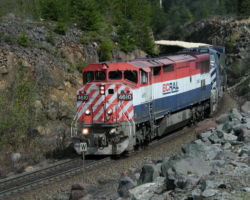
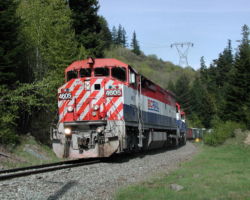
This work is copyright 2024 by Nathan D. Holmes, but all text and images are licensed and reusable under a Creative Commons Attribution-NonCommercial-ShareAlike license. Basically you’re welcome to use any of this as long as it’s not for commercial purposes, you credit me as the source, and you share any derivative works under the same license. I’d encourage others to consider similar licenses for their works.
